Abstract
Hepatocellular carcinoma (HCC) is the third most common malignancy, with a new incidence of more than 11,000 cases per year and the second most common cause of malignancy-related death in Korean males. In Korea, more than 80% of all HCCs have developed from hepatitis B virus (HBV)-related cirrhotic livers. Liver transplantation (LT) is the only treatment that offers a chance of cure for HCC and the underlying liver cirrhosis simultaneously, but the availability of liver grafts and the aggressiveness of tumor recurrence are critical limiting factors of LT for HCC patients. The serious shortage of deceased-donors on strong demand for LT leads to the development of living-donor LT (LDLT) as a practical alternative replacing deceased-donor LT. Considering that HCC recurrence is the most common cause of posttransplant patient death, recipient candidates should be pru-dently selected through objectively established criteria. Uniquely, some Asian major LDLT centers challenged the Milan criteria, accepting a much higher number of HCC nodules instead of tumor size expansion. The eligibility criteria of LDLT for HCC are likely to be expanded more than before, but it still requires further qualified risk-benefit analyses. The development of new effective treatment modalities for HCC recurrence will reasonably expand the selection criteria further wide without the expense of recurrence rate. This article is mainly focused on the role of LT for HCC and discussed on the validity of currently available indication criteria.
Go to : 
REFERENCES
1. van der Putten AB, Bijleveld CM, Slooff MJ, Wesenhagen H, Gips CH. Selection criteria and decisions in 375 patients with liver disease, considered for liver transplantation during 1977-1985. Liver. 1987; 7:84–90.
2. O'Grady JG, Polson RJ, Rolles K, Calne RY, Williams R. Liver transplantation for malignant disease. Results in 93 con-secutive patients. Ann Surg. 1988; 207:373–379.
3. Bismuth H, Chiche L, Adam R, Castaing D, Diamond T, Dennison A. Liver resection versus transplantation for hepatocellular carcinoma in cirrhotic patients. Ann Surg. 1993; 218:145–151.

4. Mazzaferro V, Regalia E, Doci R, et al. Liver transplantation for the treatment of small hepatocellular carcinomas in patients with cirrhosis. N Engl J Med. 1996; 334:693–699.

5. Yao FY, Ferrell L, Bass NM, Bacchetti P, Ascher NL, Roberts JP. Liver transplantation for hepatocellular carcinoma: comparison of the proposed UCSF criteria with the Milan criteria and the Pittsburgh modified TNM criteria. Liver Trasnpl. 2002; 8:765–774.

6. Lee SG, Hwang S, Moon DB, et al. Expanded indication criteria of living donor liver transplantation for hepatocellular carcinoma at one large-volume center. Liver Transpl. 2008; 14:935–945.

7. Kwon CH, Kim DJ, Han YS, et al. HCC in living donor liver transplantation: can we expand the Milan criteria? Dig Dis. 2007; 25:313–319.

8. Suh KS, Cho EH, Lee HW, Shin WY, Yi NJ, Lee KU. Liver trnasplantation for hepatocellular carcinoma in patients who do not meet Milan criteria. Dig Dis. 2007; 25:329–333.
9. Ito T, Takada Y, Ueda M, et al. Expansion of selection criteria for patients with hepatocellular carcinoma in living donor liver transplantation. Liver Transpl. 2007; 13:1637–1644.

10. Sugawara Y, Tamura S, Makuuchi M. Living donor liver transplantation for hepatocellular carcinoma: Tokyo University series. Dig Dis. 2007; 25:310–312.

11. Soejima Y, Taketomi A, Yoshizumi T, et al. Extended indication for living donor liver transplantation in patients with hepatocellular carcinoma. Transplantation. 2007; 83:893–899.

12. Lee SG, Ahn CS, Ha TY, et al. Liver transplantation for hepatocellular carcinoma: Korean experience. J Hepatobiliary Pancreat Surg. 2009. [Epub ahead of print].
14. Moon DB, Lee SG, Hwang S. Liver transplantation for hepatocellular carcinoma: single nodule with Child-Pugh class A sized less than 3 cm. Dig Dis. 2007; 25:320–328.

15. Gondolesi GE, Roayaie S, Munoz L, et al. Adult living donor liver transplantation for patient hepatocellular carcinoma: ex-tending UNOS priority criteria. Ann Surg. 2004; 239:142–149.
16. Lo CM, Fan ST, Liu CL, Chan SC, Wong J. The role and limitation of living donor liver transplantation. Liver Transpl. 2004; 10:440–447.
17. Lo CM, Fan ST, Liu CL, Chan SC, Ng IO, Wong J. Living donor versus deceased donor liver transplantation for early ir-resectable hepatocellular carcinoma. Br J Surg. 2007; 94:78–86.

18. Hiatt JR, Carmody IC, Busuttil RW. Should we expand the criteria for hepatocellular carcinoma with living donor liver transplantation? -no, never. J Hepatol. 2005; 43:573–577.
19. Marcos A, Fisher RA, Ham JM, et al. Liver regeneration and function in donor and recipient after right lobe adult to adult living donor liver transplantation. Transplantation. 2000; 69:1375–1379.
20. Drixler TA, Vogten MJ, Ritchie ED, et al. Liver regeneration is anangiogenesis-associated phenomenon. Ann Surg. 2002; 236:703–712.
21. Todo S, Furukawa H: The Japanese Study Group on Organ Transplantation. Living donor liver transplantation for adult patients with hepatocellular carcinoma: experience in Japan. Ann Surg. 2004; 240:451–459.
22. Hwang S, Lee SG, Joh JW, Suh KS, Kim DG. Liver transplantation for adult patients with hepatocellular carcinoma in Korea: comparison between cadaveric donor and living donor liver transplantations. Liver Transpl. 2005; 11:1265–1272.

23. Hwang S, Lee SG, Belghiti J. Liver transplantation for HCC: its role. Eastern and western perspectives. J Hepatobiliary Pancreat Surg. 2009. (Epub ahead of print).
24. Yao FY, Ferrel L, Bass NM, et al. Liver transplantation for hepatocellular carcinoma: expansion of the tumor size limits does not adversely impact survival. Hepatology. 2001; 33:1394–1403.

25. Yao FY, Bass NM, Nikolai B, et al. Liver transplantation for hepatocellular carcinoma: analysis of survival according to the intention-to-treat principle and dropout from waiting list. Liver Transpl. 2002; 8:873–883.
26. Furukawa H, Shimamura T, Suzuki T, et al. Liver transplantation for hepatocellular carcinoma: the Japanese experience. J Hepatobiliary Pancreat Surg. 2009. [Epub ahead of print].

27. Trotter JF, Adam R, Lo CM, Kenison J. Documented deaths of hepatic lobe donors for living donor liver transplantation. Liver Transpl. 2006; 12:1485–1488.

28. Lo CM, Fan ST, Liu CL, et al. Lessons learned from one hundred right lobe living donor liver transplants. Ann Surg. 2004; 240:151–158.

29. Hwang S, Lee SG, Lee YJ, et al. Lessons learned from 1,000 living donor liver transplantations in a single center: how to make living donations safe. Liver Transpl. 2006; 12:920–927.

30. Marsh JW, Gray E, Ness R, Starzl TE. Complications of right lobe living donor liver transplantation. J Hepatol. 2009; 51:715–724.

31. Bruix J, Fuster J, Llovet JM. Liver transplantation for hepto-cellular carcinoma: foucault pendulum versus evidence-based decision. Liver Transpl. 2003; 9:700–702.
32. Cillo U, Vitale A, Bassanello M, et al. Liver transplantation for the treatment for moderately and well-differentiated hepatocellular carcinoma. Ann Surg. 2004; 239:150–159.
33. Marshall AE, Rushbrook SM, Voeler SL, et al. Tumor recurrence following liver transplantation for hepatocellular carcinoma: role of tumor proliferation status. Liver Transpl. 2010; 16:279–288.

34. Durand F, Regimbeau JM, Belghiti J, et al. Assessment of the benefits and risks of percutaneous biopsy before surgical resection of hepatocellular carcinoma. J Hepatol. 2001; 35:254–258.

35. Perkins JD. Seeding risk following percutaneous approach to hepatocellular carcinoma. Liver Transpl. 2007; 13:1603–1607.

36. Han K, Tzimas GN, Barkun JS, et al. Preoperative alphafetoprotein slope is predictive of hepatocellular carcinoma recurrence after liver transplantation. Can J Gastroenterol. 2007; 21:39–45.

37. Nanashima A, Morino S, Yamaguchi H, et al. Modified CLIP using PIVKA-II for evaluating prognosis after hepatoctomy for hepatocellular carcinoma. Eur J Surg Oncol. 2003; 29:735–742.
38. Taketomi A, Sanefuji K, Soejima Y, et al. Impact of des- gamma-carboxy prothrombin and tumor size on the recurrence of hepatocellular carcinoma after living donor liver transplantation. Transplantation. 2009; 87:531–537.
39. Hatano E, Ikai I, Higashi T, et al. Preoperative positron emission tomography with fluorine-18-fluorodeoxyglucose is predictive of prognosis in patients with hepatocellular carcinoma after resection. World J Surg. 2006; 30:1736–1741.

40. Yang SH, Suh KS, Lee HW, et al. The role of (18)F-FDG- PET imaging for the selection of liver transplantation candidates among hepatocellular carcinoma patients. Liver Transpl. 2006; 12:1655–1660.
41. Yang SH, Suh KS, Lee HW, et al. A revised scoring system utilizing serum alphafetoprotein level to expand candidates for living donor liver transplantation in hepatocellular carcinoma. Surgery. 2007; 141:598–609.
42. Voulgari A, Pintzas A. Epithelial-mesenchymal transition in cancer metastasis: mechanisms, markers and strategies to over-come drug resistance in the clinic. Biochim Biophys Acta. 2009; 1796:75–90.

43. Lee JS, Chu IS, Heo J, et al. Classification and prediction of survival in hepatocellular carcinoma by gene expression profiling. Hepatology. 2004; 40:667–676.

44. Lubienski A. Hepatocellular carcinoma: interventional bridging to liver transplantation. Transplantation. 2005; 80(suppl 1):S113–S119.

45. Yao FY, Kerlan RK Jr, Hirose R, et al. Excellent outcome following down-staging of hepatocellular carcinoma prior to liver transplantation: an intention-to-treat analysis. Hepatology. 2008; 48:819–827.

46. Soderdahl G, Backman L, Isoniemi H, et al. A prospective, randomized, multicentre trial of systemic adjuvant chemotherapy versus no additional treatment in liver transplantation for hepatocellular carcinoma. Transpl Int. 2006; 19:288–294.

47. Porrett PM, Peterman H, Rosen M, et al. Lack of benefit of pretransplant locoregional hepatic therapy for hepatocellular cancer in the current MELD era. Liver Transpl. 2006; 12:665–673.

48. Decaens T, Roudot-Thoraval F, Bresson-Hadni S, et al. Impact of pretransplantation transarterial chemoembolization on survival and recurrence after liver transplantation for hepatocellular carcinoma. Liver Transpl. 2005; 11:767–775.

49. Perez Saborido B, Meneu JC, Moreno E, et al. Is transarterial chemoembolization necessary before liver transplantation for hepatocellular carcinoma? Am J Surg. 2005; 190:383–387.
50. Adam R, Azoulay D, Castaing D, et al. Liver resection as a bridge to transplantation for hepatocellular carcinoma on cirrhosis: a reasonable strategy? Ann Surg. 2003; 238:508–519.
51. Belghiti J, Cortes A, Abdalla EK, et al. Resection prior to liver resection for hepatocellular carcinoma. Ann Surg. 2003; 238:885–893.
52. Hwang S, Lee SG, Moon DB, et al. Salvage living donor liver transplantation after prior liver resection for hepatocellular carcinoma. Liver Transpl. 2007; 13:741–746.

53. Schlitt HJ, Neipp M, Weimann A, et al. Recurrence patterns of hepatocellular and fibrolamellar carcinoma aftre liver transplantation. J Clin Oncol. 1999; 17:324–331.
54. Yokoyama I, Carr B, Saitsu H, Iwatsuki S, Starzl TE. Accelerated growth rates of recurrent hepatocellular carcinoma after liver transplantation. Cancer. 1991; 68:2095–2100.

55. Kornberg A, Kü pper B, Tannapfel A, et al. Longterm survival after recurrent hepatocellular carcinoma in liver transplant patients: clinical patterns and outcome variables. Eur J Surg Oncol. 2010; 36:275–280.

56. Taketomi A, Fukuhara T, Morita K, et al. Improved results of a surgical resection for the recurrence of hepatocellular carcinoma after living donor liver transplantation. Ann Surg Oncol. 2010. [Epub ahead of print].

57. Valdivieso A, Bustamante J, Gastaca M, et al. Management of hepatocellular carcinoma recurrence after liver transplantation. Transplant Proc. 2010; 42:660–662.

58. Roayaie S, Schwarts JD, Sung MW, et al. Recurrence of hepatocellular carcinoma after liver transplant: patterns of prognosis. Liver Transpl. 2004; 10:534–540.
59. Lee JO, Kim DY, Lim JH, et al. Palliative chemotherapy for patients with recurrent hepatocellular carcinoma after liver transplantation. J Gastroenterol Hepatol. 2009; 24:800–805.

60. Vivarelli M, Cucchetti A, Piscaglia F, et al. Analysis of risk factors for tumor recurrence after liver transplantation for hepatocellular carcinoma: key role of immunosuppression. Liver Transpl. 2005; 11:497–503.

61. Vivarelli M, Cuccetti A, La Barba G, et al. Liver transplantation for hepatocellular carcinoma under calcineurin inhibitors: reassessment of risk factors for tumor recurrence. Ann Surg. 2008; 248:857–862.
62. Wang Z, Zhou J, Fan J, et al. Sirolimus inhibits the growth and metastatic progression of hepatocellular carcinoma. J Cancer Res Clin Oncol. 2009; 135:715–722.

63. Toso C, Meeberg GA, Bigam DL, et al. De novo sirolimus- based immunosuppression after liver transplantation for hepatocellular carcinoma: longterm outcomes and side effects. Transplantation. 2007; 83:1162–1168.
Go to : 
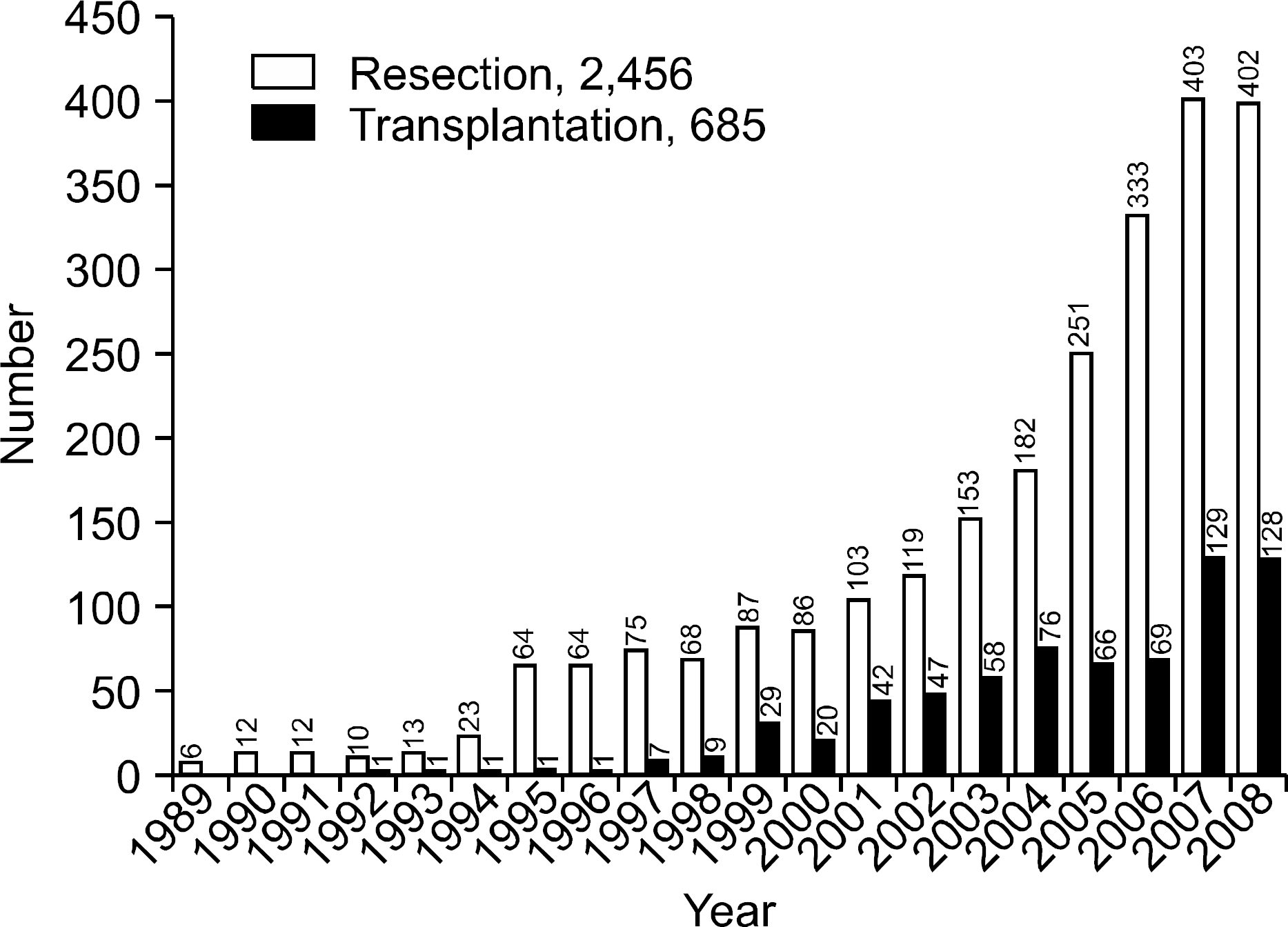 | Fig. 1.Liver resection and transplantation for hepatocellular carcinoma at Asan Medical Center from June 1989 to December 2008. |
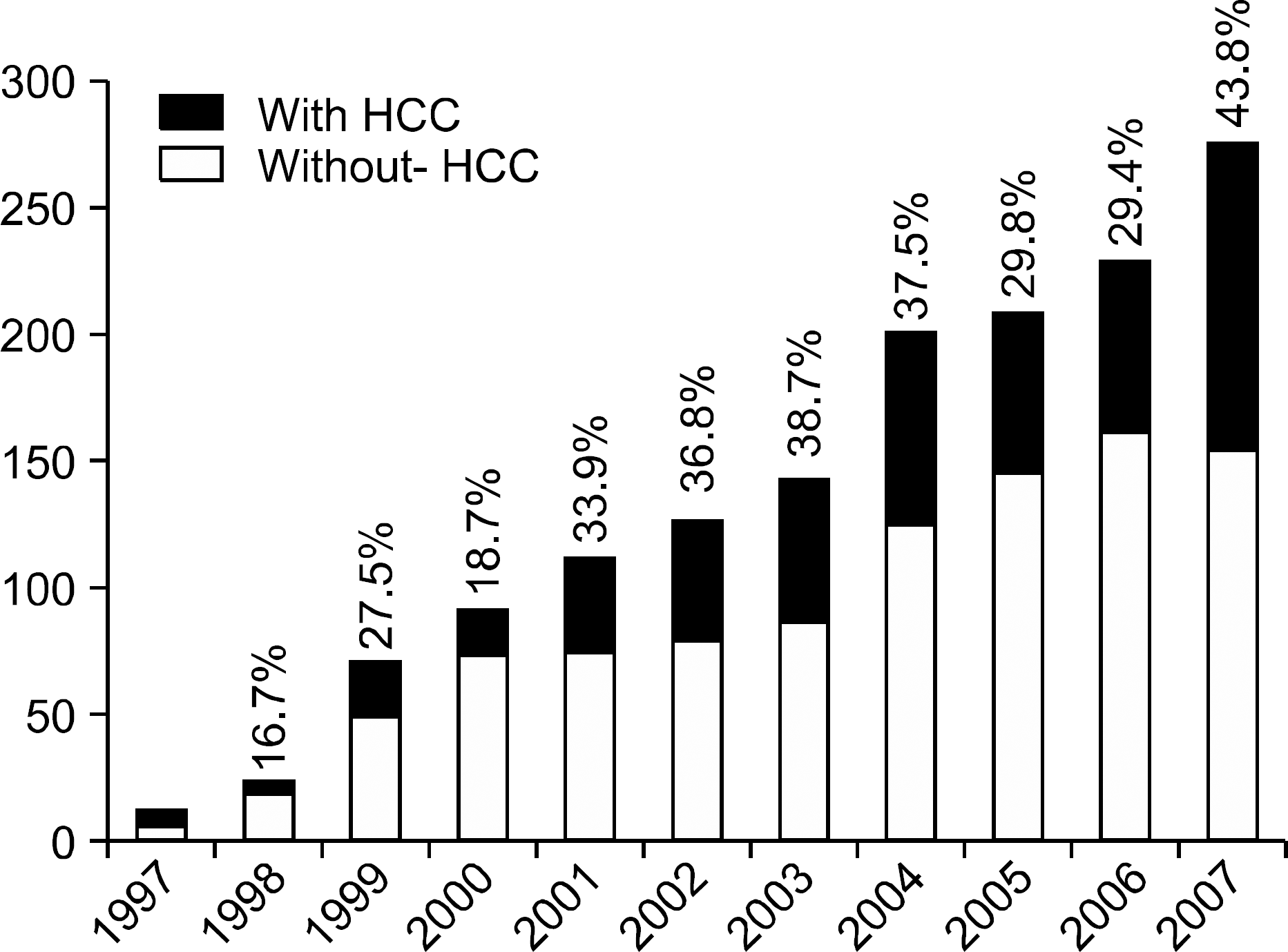 | Fig. 2.Annual changes in the proportion of hepatocellular carcinoma patients in adult living-donor liver transplantation at Asan Medical Center. |
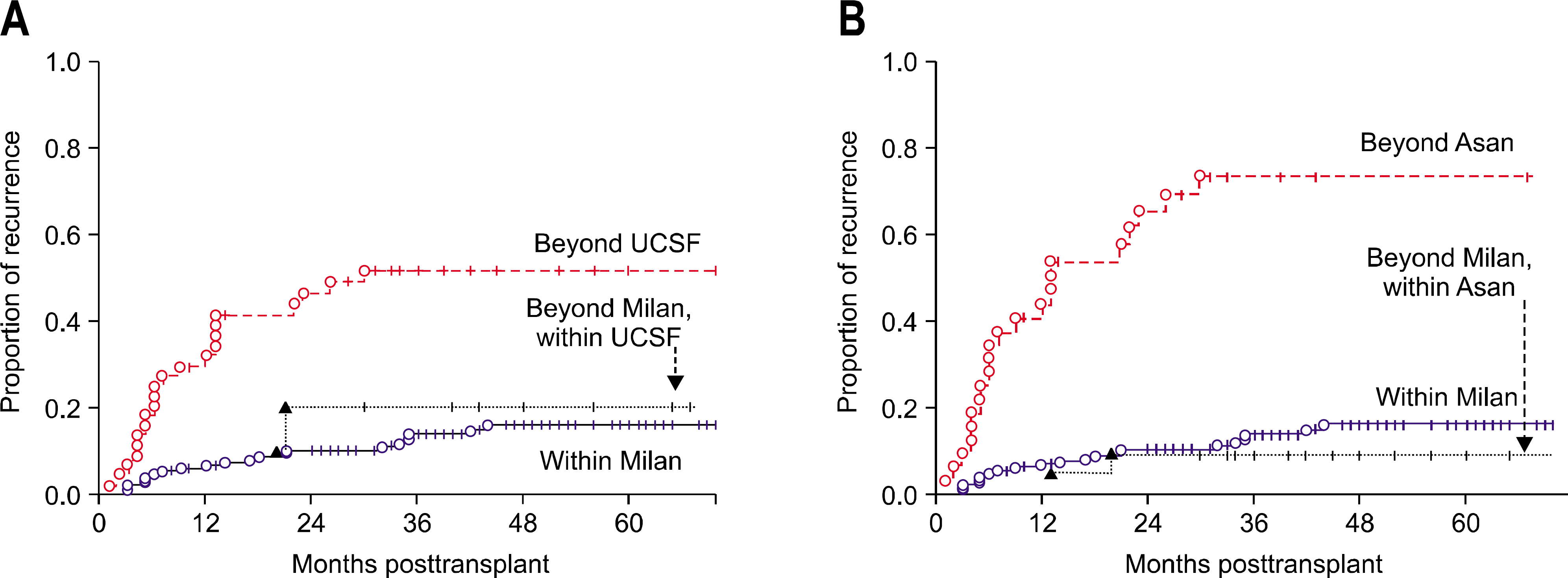 | Fig. 3.Comparison of the hepatocellular carcinoma (HCC) recurrence curves of 206 patients who underwent living-donor liver transplantation from February 1997 to December 2004 at Asan Medical Center based on explant pathology. (A) HCC recurrence curves of the patients beyond the Milan criteria but within UCSF criteria showed 1-year, 3-year, and 5-year recurrence rates of 0%, 20.0%, and 20.0%, respectively. There was no statistically significant difference in recurrence rates between the patient group beyond the Milan criteria but within the UCSF criteria and the patient group within the Milan criteria (p=0.626). (B) HCC recurrence curves of the patients beyond the Milan criteria but within the Asan criteria showed 1-year, 3-year, and 5-year recurrence rates of 0%, 9.1%, and 9.1%, respectively. There was no statistically significant recurrence difference between the patient group beyond the Milan criteria but within the Asan criteria and that within the Milan criteria (p=0.554).6
|
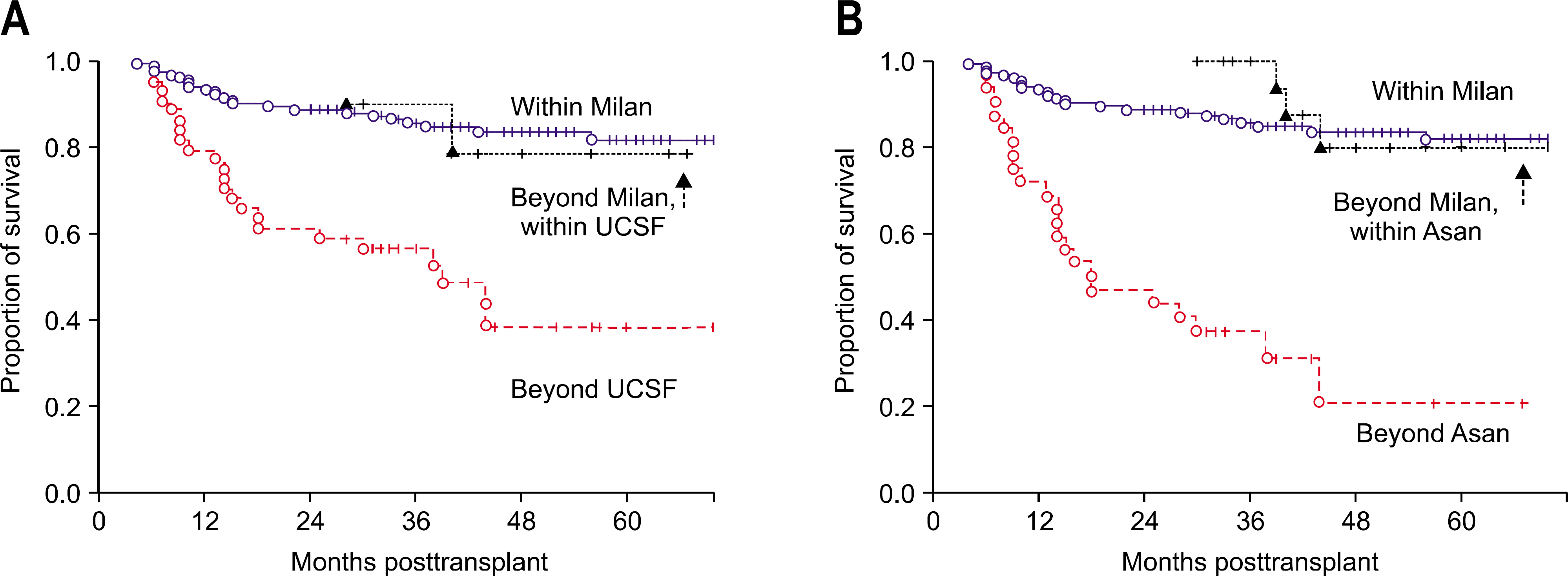 | Fig. 4.Comparison of the patient survival curves of 206 patients who underwent living-donor liver transplantation from February 1997 to December 2004 at Asan Medical Center based on explant pathology. (A) Patient survival curves of the patients beyond the Milan criteria but within UCSF criteria showed 1-year, 3-year, and 5-year survival rates of 100%, 90.0%, and 78.8%, respectively. There was no statistically significant difference in survival rates between the patient group beyond the Milan criteria but within the UCSF criteria and the patient group within the Milan criteria (p=0.923). (B) Patient survival curves of patients beyond the Milan criteria but within the Asan criteria showed 1-year, 3-year, and 5-year recurrence rates of 100%, 88.9%, and 80.0%, respectively. There was no statistically significant survival difference between the patient group beyond the Milan criteria but within the Asan criteria and that within the Milan criteria 6
|
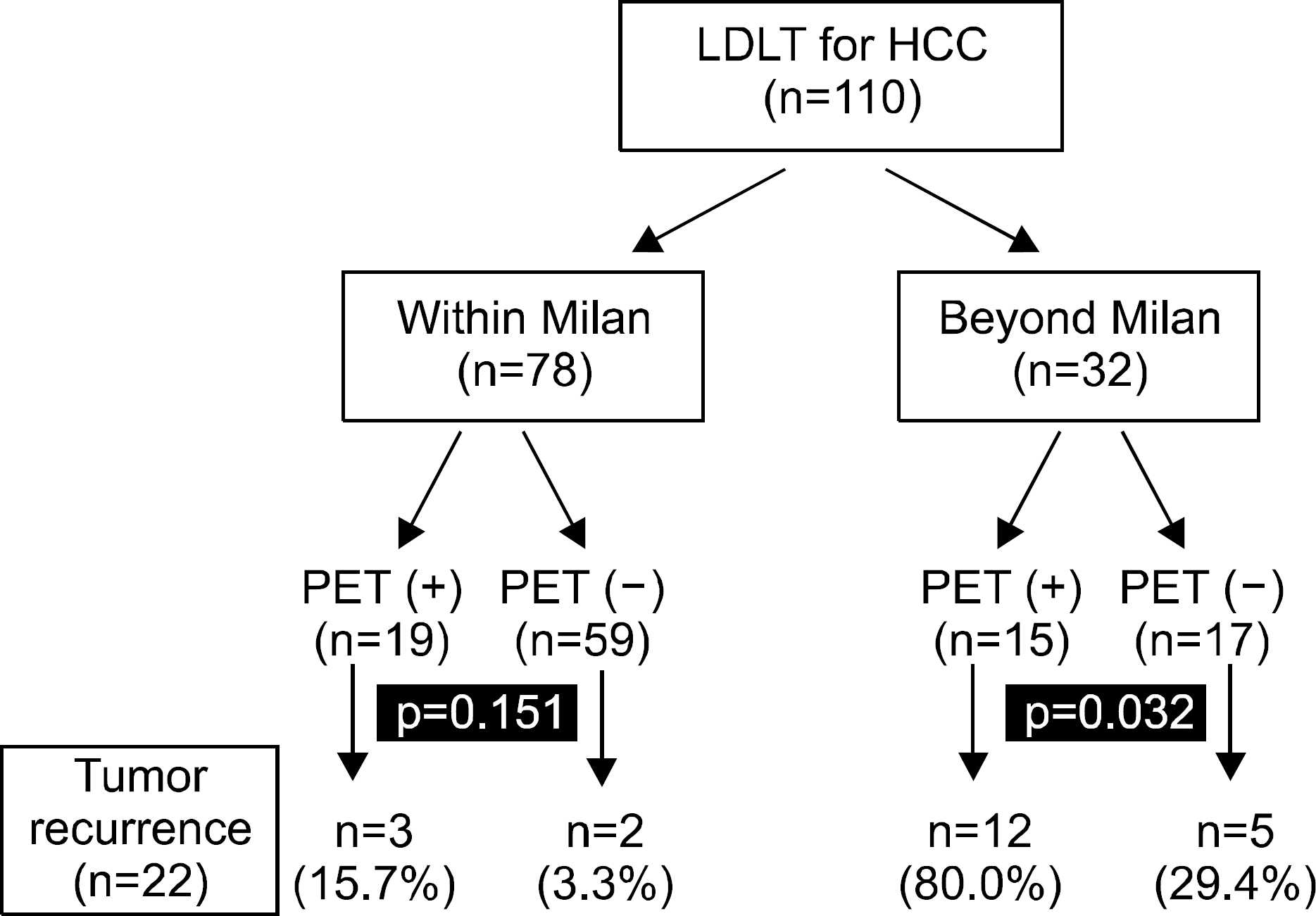 | Fig. 5.Recurrence of hepatocellular carcinoma in recipients having positive positron emission tomography (PET) scans. LDLT, living-donor liver transplantation. |
Table 1.
Eligibility Criteria of Liver Transplantation for Hepatocellular Carcinoma
Table 2.
Comparison of Data and Outcomes of the HCC Patients Who Underwent Deceased-donor and Living-donor Liver Transplantations (DDLT and LDLT) at 4 Centers of Korea from August 1992 to December 200222
Table 3.
Risk Factors for Hepatocellular Carcinoma Recurrence and Patient Survival in 206 Patients Who Underwent Living-donor Liver Transplants from February 1997 to December 2004 at Asan Medical Center6




 PDF
PDF ePub
ePub Citation
Citation Print
Print


 XML Download
XML Download